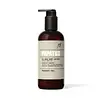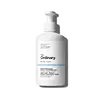What's inside
What's inside
 Key Ingredients
Key Ingredients

 Benefits
Benefits

 Concerns
Concerns

 Ingredients Side-by-side
Ingredients Side-by-side

Water
Skin ConditioningAcetamidoethoxyethanol
HumectantZea Mays Starch
AbsorbentDimethicone/Vinyl Dimethicone Crosspolymer
Skin ConditioningPropanediol
SolventNiacinamide
SmoothingCeramide NP
Skin ConditioningCaprylic/Capric Triglyceride
MaskingEthylhexylglycerin
Skin ConditioningPhenoxyethanol
PreservativeCarbomer
Emulsion StabilisingSodium Hydroxide
BufferingSilica
AbrasiveZinc Gluconate
Skin ConditioningButylene Glycol
HumectantPolyglyceryl-10 Stearate
Skin ConditioningHydrogenated Lecithin
EmulsifyingSucrose Stearate
EmollientTocopherol
AntioxidantWater, Acetamidoethoxyethanol, Zea Mays Starch, Dimethicone/Vinyl Dimethicone Crosspolymer, Propanediol, Niacinamide, Ceramide NP, Caprylic/Capric Triglyceride, Ethylhexylglycerin, Phenoxyethanol, Carbomer, Sodium Hydroxide, Silica, Zinc Gluconate, Butylene Glycol, Polyglyceryl-10 Stearate, Hydrogenated Lecithin, Sucrose Stearate, Tocopherol
Water
Skin ConditioningCaprylic/Capric Triglyceride
MaskingGlycerin
HumectantInulin
Skin ConditioningPropanediol
SolventIsodecyl Neopentanoate
EmollientArachidyl Alcohol
EmollientRhus Succedanea Fruit Wax
Sodium Hyaluronate
HumectantArginine
MaskingGlycine
BufferingAlanine
MaskingSerine
MaskingProline
Skin ConditioningThreonine
Glutamic Acid
HumectantLysine Hcl
Skin ConditioningBetaine
HumectantSodium PCA
HumectantPCA
HumectantXylitylglucoside
HumectantAnhydroxylitol
HumectantXylitol
HumectantGlucose
HumectantMaltose
MaskingFructose
HumectantSucrose
HumectantTrehalose
HumectantSodium Lactate
BufferingUrea
BufferingAllantoin
Skin ConditioningBehenyl Alcohol
EmollientArachidyl Glucoside
EmulsifyingPentylene Glycol
Skin ConditioningPolyacrylate Crosspolymer-6
Emulsion StabilisingXanthan Gum
EmulsifyingTrisodium Ethylenediamine Disuccinate
Tocopherol
AntioxidantCitric Acid
BufferingSodium Hydroxide
BufferingSodium Chloride
MaskingEthylhexylglycerin
Skin ConditioningPhenoxyethanol
PreservativeChlorphenesin
AntimicrobialWater, Caprylic/Capric Triglyceride, Glycerin, Inulin, Propanediol, Isodecyl Neopentanoate, Arachidyl Alcohol, Rhus Succedanea Fruit Wax, Sodium Hyaluronate, Arginine, Glycine, Alanine, Serine, Proline, Threonine, Glutamic Acid, Lysine Hcl, Betaine, Sodium PCA, PCA, Xylitylglucoside, Anhydroxylitol, Xylitol, Glucose, Maltose, Fructose, Sucrose, Trehalose, Sodium Lactate, Urea, Allantoin, Behenyl Alcohol, Arachidyl Glucoside, Pentylene Glycol, Polyacrylate Crosspolymer-6, Xanthan Gum, Trisodium Ethylenediamine Disuccinate, Tocopherol, Citric Acid, Sodium Hydroxide, Sodium Chloride, Ethylhexylglycerin, Phenoxyethanol, Chlorphenesin
 Reviews
Reviews

Ingredients Explained
These ingredients are found in both products.
Ingredients higher up in an ingredient list are typically present in a larger amount.
This ingredient is an emollient, solvent, and texture enhancer. It is considered a skin-softener by helping the skin prevent moisture loss.
It helps thicken a product's formula and makes it easier to spread by dissolving clumping compounds.
Caprylic Triglyceride is made by combining glycerin with coconut oil, forming a clear liquid.
While there is an assumption Caprylic Triglyceride can clog pores due to it being derived from coconut oil, there is no research supporting this.
Learn more about Caprylic/Capric TriglycerideEthylhexylglycerin (we can't pronounce this either) is commonly used as a preservative and skin softener. It is derived from glyceryl.
You might see Ethylhexylglycerin often paired with other preservatives such as phenoxyethanol. Ethylhexylglycerin has been found to increase the effectiveness of these other preservatives.
Phenoxyethanol is a preservative that has germicide, antimicrobial, and aromatic properties. Studies show that phenoxyethanol can prevent microbial growth. By itself, it has a scent that is similar to that of a rose.
It's often used in formulations along with Caprylyl Glycol to preserve the shelf life of products.
Propanediol is an all-star ingredient. It softens, hydrates, and smooths the skin.
It’s often used to:
Propanediol is not likely to cause sensitivity and considered safe to use. It is derived from corn or petroleum with a clear color and no scent.
Learn more about PropanediolSodium Hydroxide is also known as lye or caustic soda. It is used to adjust the pH of products; many ingredients require a specific pH to be effective.
In small amounts, sodium hydroxide is considered safe to use. However, large amounts may cause chemical burns due to its high alkaline.
Your skin has a natural pH and acid mantle. This acid mantle helps prevent harmful bacteria from breaking through. The acid mantle also helps keep your skin hydrated.
"Alkaline" refers to a high pH level. A low pH level would be considered acidic.
Learn more about Sodium HydroxideTocopherol (also known as Vitamin E) is a common antioxidant used to help protect the skin from free-radicals and strengthen the skin barrier. It's also fat soluble - this means our skin is great at absorbing it.
Vitamin E also helps keep your natural skin lipids healthy. Your lipid skin barrier naturally consists of lipids, ceramides, and fatty acids. Vitamin E offers extra protection for your skin’s lipid barrier, keeping your skin healthy and nourished.
Another benefit is a bit of UV protection. Vitamin E helps reduce the damage caused by UVB rays. (It should not replace your sunscreen). Combining it with Vitamin C can decrease sunburned cells and hyperpigmentation after UV exposure.
You might have noticed Vitamin E + C often paired together. This is because it is great at stabilizing Vitamin C. Using the two together helps increase the effectiveness of both ingredients.
There are often claims that Vitamin E can reduce/prevent scarring, but these claims haven't been confirmed by scientific research.
Learn more about TocopherolWater. It's the most common cosmetic ingredient of all. You'll usually see it at the top of ingredient lists, meaning that it makes up the largest part of the product.
So why is it so popular? Water most often acts as a solvent - this means that it helps dissolve other ingredients into the formulation.
You'll also recognize water as that liquid we all need to stay alive. If you see this, drink a glass of water. Stay hydrated!
Learn more about Water